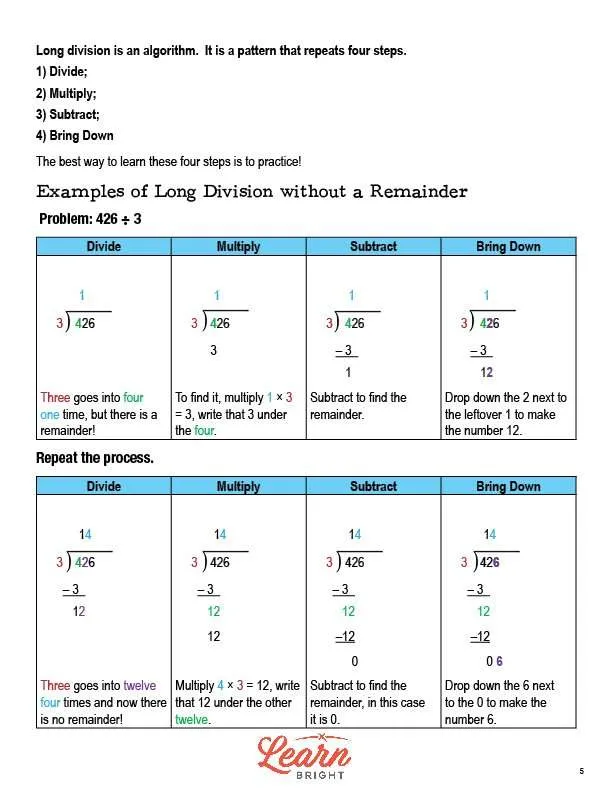Description
What our Long Division – Grades 4-5 lesson plan includes
Lesson Objectives and Overview: Long Division – Grades 4-5 provides several examples of the steps of long division with a single digit as the divisor. The lesson also demonstrates examples with and without remainders. At the end of the lesson, students will be able to apply the long division algorithm to solve multi-digit division problems. This lesson is for students in 4th grade and 5th grade.
Classroom Procedure
Every lesson plan provides you with a classroom procedure page that outlines a step-by-step guide to follow. You do not have to follow the guide exactly. The guide helps you organize the lesson and details when to hand out worksheets. It also lists information in the blue box that you might find useful. You will find the lesson objectives, state standards, and number of class sessions the lesson should take to complete in this area. In addition, it describes the supplies you will need as well as what and how you need to prepare beforehand.
Options for Lesson
Included with this lesson is an “Options for Lesson” section that lists a number of suggestions for activities to add to the lesson or substitutions for the ones already in the lesson. One optional addition to this lesson is to have your students use graph paper to practice long division problems. You could have your students roll dice to create problems to solve. They could also make videos about how to do long division. Another idea for an additional activity is to have your students create a song to help them remember the long division steps. Finally, to help reinforce the concepts in the lesson, you could have your students explain to each other how to solve problems.
Teacher Notes
The teacher notes page includes lines that you can use to add your own notes as you’re preparing for this lesson.
LONG DIVISION – GRADES 4-5 LESSON PLAN CONTENT PAGES
Long Division
The Long Division – Grades 4-5 lesson plan includes four content pages. We use long division to solve division problems with two or more digits. Before learning long division, students should have a strong grasp on their multiplication facts.
The first step in long division is to set up the problem with the long division symbol where the quotient is written on top, the divisor on the left side, and the dividend on the right side. We can then begin to solve. For example, let’s look at the problem 84 ÷ 2. To solve, we first ask ourselves how many times 2 goes into 8. The answer is 4, so we write 4 on top of the 8. Next, we ask ourselves how many times 2 goes into 4. The answer is 2, so we write 2 on top of the 4. Therefore, the quotient (answer) is 42.
In this example, the divisor goes into each digit of the dividend equally. The lesson walks students through another example where this is true: 96 ÷ 3. The quotient is 32. 3 goes into both 9 and 6 evenly.
However, sometimes the divisor will not go into the dividend evenly. When this happens, we need to look at the next digit as well. For example, let’s look at the problem 208 ÷ 4. To start, we ask ourselves how many times 4 goes into 2. However, 4 does not go into 2, so we need to include the next number as well. Now we ask ourselves how many times 4 goes into 20. The answer is 5, so we write 5 on top of the 0. Next, we ask how many times 4 goes into 8. The answer is 2, so we write 2 above the 8. We get a quotient of 52.
The lesson includes a second example problem, 246 ÷ 6, which follows the same steps. No matter what the problem is, we need to remember that long division is an algorithm, or a pattern that repeats. The four steps to solving long division problems are divide, multiply, subtract, and bring down.
Examples of Long Division without a Remainder
The lesson includes a few examples of long division problems without remainders, walking through each problem step-by-step. Students should review these examples, paying attention to each step.
Once we find the quotient for a long division problem, we should double-check our answer. Because the inverse of division is multiplication, we can multiply the quotient and divisor to check whether our answer is correct. If the two numbers match, our answer is correct!
LONG DIVISION – GRADES 4-5 LESSON PLAN WORKSHEETS
The Long Division – Grades 4-5 lesson plan includes four worksheets: an activity worksheet, a practice worksheet, a homework assignment, and a quiz. You can refer to the guide on the classroom procedure page to determine when to hand out each worksheet.
CAR RACE ACTIVITY WORKSHEET
Students will work in groups to complete the activity worksheet. The students will take turns choosing a card and solving the problem on the card. If they get the correct answer, they move their marker ahead one space. The first student to reach the finish line wins!
SETTING UP PROBLEMS PRACTICE WORKSHEET
For the practice worksheet, students will set up the division problems on the worksheet and solve using long division.
LONG DIVISION HOMEWORK ASSIGNMENT
Like the practice worksheet, for the homework assignment, students will set up the division problems on the worksheet and solve using long division. They will also answer a long division word problem.
QUIZ
This lesson also includes a quiz that you can use to test students’ understanding of the lesson material. Like the homework assignment, for the quiz, students will set up the division problems on the worksheet and solve using long division. They will also answer a long division word problem.
Worksheet Answer Keys
This lesson plan includes answer keys for the practice worksheet, the homework assignment, and the quiz. If you choose to administer the lesson pages to your students via PDF, you will need to save a new file that omits these pages. Otherwise, you can simply print out the applicable pages and keep these as reference for yourself when grading assignments.









